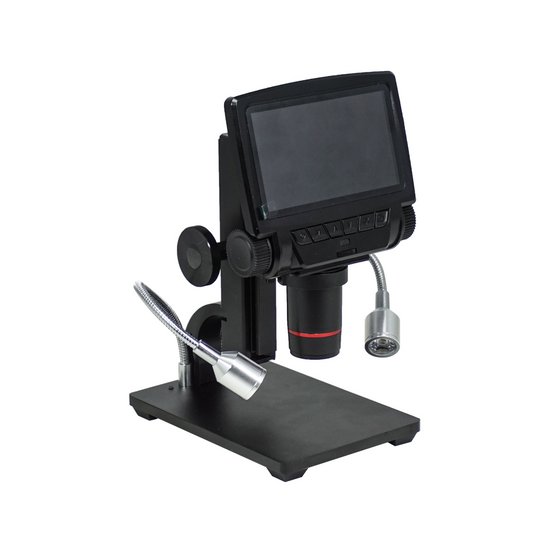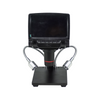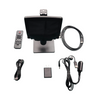Instruction Manual
DM02050121 Digital Microscope Instruction Manual-English.pdf
Software Download
DM02050121 software.zip
Quick Overview
Finite. Total Magnification: 20X. Track Stand. Illumination Type: LED Reflection Light. 12 Megapixels. HDMI / AV. Screen Size: 5in. Input Voltage: AC 100-240V 50/60Hz.
DM02050121 Digital Microscope Instruction Manual-English.pdf
Software Download
DM02050121 software.zip
Quick Overview
Finite. Total Magnification: 20X. Track Stand. Illumination Type: LED Reflection Light. 12 Megapixels. HDMI / AV. Screen Size: 5in. Input Voltage: AC 100-240V 50/60Hz.
DM02050121 Digital Microscope
Optical System Specifications
| Optical System | Finite |
| Total Magnification | 20X |
| System Working Distance | 50-150mm |
Track Stand
| Stand Type | Track Stand |
| Holder Adapter Type | Dia. 38mm Scope Holder |
| Track Length | 155mm |
| Base Type | Table Base |
| Base Shape | Rectangle |
| Stand Throat Depth | 56mm |
| Base Dimensions | 165x120x5mm |
| Focus Mode | Manual |
| Focus Distance | 63mm |
| Coarse Focus Distance per Rotation | 21mm |
Microscope Illumination System
| Illumination Type | LED Reflection Light |
LCD Display Digital Camera
| Camera Maximum Pixels | 12 Megapixels |
| Camera Resolution | 4032x3024 |
| Camera Signal Output Port | HDMI / AV |
| Exposure Control | Manual |
| Image Capture Output Format | JPEG |
| Video Output Format | MOV |
| Language | English/French/Spanish/German/Italian/Simplified Chinese/Traditional Chinese/Japanese/Korean/Russian/Thai/Hebrew/Portuguese/Turkish/Czech/Polish |
| Memory Type | TF |
| Memory Capacity | 32G |
| Screen Size | 5in |
| Screen Aspect Ratio | 4:3 |
Power Supply
| Input Voltage | AC 100-240V 50/60Hz |
| Output Voltage | DC 5V |
| Power Cord Connector Type | USA 2 Pins |
| Power Cable Length | 2.4m |
Other Parameters
| Surface Treatment | Plastic Spray Coating |
| Material | Plastic |
| Color | Black |
| Net Weight | 1.30kg (2.866lbs) |
Series
| DM0205 | DM02050121 |
Technical Info
Instructions
Digital MicroscopeClose Λ
| Digital microscope is the general term for microscope that can convert an optical image into a digital image, and usually does not specifically refer to a certain type of microscope. It should be noted however that most microscopes can be mounted with cameras and display devices to change to digital microscope. Microscopes in the visible range, from the digital imaging point of view, all use CCD or CMOS sensors to image the optical signal as an electric signal on a computer or display. However, the difference between various kinds of digital microscopes mainly comes from the optical microscope itself, so it is necessary to look at the imaging effect and function of the optical part in order to select the type of digital microscope. From the classification point of view, digital microscopes can be divided into: digital biological microscopes, digital stereo microscopes, etc. It should be noted that due to the variety of lenses, ordinary lenses or microscopes, if mounted with a digital camera, can all become a digital microscope. At present, the trend of digital microscopes is not only to present simple digital images, but to collect, process and analyze images through back-end software, especially for image measurement, comparison, judgment, and large-format scanning and splicing, and three-dimensional synthesis and so on, these aspects have been widely developed and applied. |
FiniteClose Λ
| Microscopes and components have two types of optical path design structures. One type is finite optical structural design, in which light passing through the objective lens is directed at the intermediate image plane (located in the front focal plane of the eyepiece) and converges at that point. The finite structure is an integrated design, with a compact structure, and it is a kind of economical microscope. Another type is infinite optical structural design, in which the light between the tube lens after passing the objective lens becomes "parallel light". Within this distance, various kinds of optical components necessary such as beam splitters or optical filters call be added, and at the same time, this kind of design has better imaging results. As the design is modular, it is also called modular microscope. The modular structure facilitates the addition of different imaging and lighting accessories in the middle of the system as required. The main components of infinite and finite, especially objective lens, are usually not interchangeable for use, and even if they can be imaged, the image quality will also have some defects. The separative two-objective lens structure of the dual-light path of stereo microscope (SZ/FS microscope) is also known as Greenough. Parallel optical microscope uses a parallel structure (PZ microscope), which is different from the separative two-object lens structure, and because its objective lens is one and the same, it is therefore also known as the CMO common main objective. |
Total MagnificationClose Λ
| Total magnification is the magnification of the observed object finally obtained by the instrument. This magnification is often the product of the optical magnification and the electronic magnification. When it is only optically magnified, the total magnification will be the optical magnification. Total magnification = optical magnification X electronic magnification Total magnification = (objective X photo eyepiece) X (display size / camera sensor target ) |
System Working DistanceClose Λ
| Working distance, also referred to as WD, is usually the vertical distance from the foremost surface end of the objective lens of the microscope to the surface of the observed object. When the working distance or WD is large, the space between the objective lens and the object to be observed is also large, which can facilitate operation and the use of corresponding lighting conditions. In general, system working distance is the working distance of the objective lens. When some other equipment, such as a light source etc., is used below the objective lens, the working distance (i.e., space) will become smaller. Working distance or WD is related to the design of the working distance of the objective lens. Generally speaking, the bigger the magnification of the objective lens, the smaller the working distance. Conversely, the smaller the magnification of the objective lens, the greater the working distance. When it is necessary to change the working distance requirement, it can be realized by changing the magnification of the objective lens. |
Track StandClose Λ
| Throughout the focusing range, the track stand moves up and down along the guide rail through the focusing mechanism to achieve the purpose of focusing the microscope. This kind of structure is relatively stable, and the microscope is always kept moving up and down vertically along a central axis. When the focus is adjusted, it is not easy to shake, and there is no free sliding phenomenon. It is a relatively common and safe and reliable accessory. The size of the stand is generally small, flexible and convenient, and most of them are placed on the table for use, Therefore, together with the post stand, it is also called “desktop or table top stand". With regard to the height of the stand, most manufacturers usually do not make it very high. If the guide rail is long, it is easy to deform, and relatively more difficult . |
Stand Throat DepthClose Λ
| Stand throat depth, also known as the throat depth, is an important parameter when selecting a microscope stand. When observing a relatively large object, a relatively large space is required, and a large throat depth can accommodate the object to move to the microscope observation center. |
LCD Display Digital CameraClose Λ
| LCD display digital camera is a combination of a digital camera and a display. |
Camera Maximum PixelsClose Λ
| The pixel is determined by the number of photosensitive elements on the photoelectric sensor of the camera, and one photosensitive element corresponds to one pixel. Therefore, the more photosensitive elements, the larger the number of pixels; the better the imaging quality of the camera, and the higher the corresponding cost. The pixel unit is one, for example, 1.3 million pixels means 1.3 million pixels points, expressed as 1.3MP (Megapixels). |
Camera ResolutionClose Λ
| Resolution of the camera refers to the number of pixels accommodated within unit area of the image sensor of the camera. Image resolution is not represented by area, but by the number of pixels accommodated within the unit length of the rectangular side. The unit of length is generally represented by inch. |
Camera Signal Output PortClose Λ
| Digital signals output: USB 2.0, USB3.0; 15 Pin VGA; Firewire Port; HDMI; VGA; Camera Link etc. Analog signal output: BNC; RCA; Y-C etc. In addition, some cameras store and output images in the form of a memory card. Usually, industrial cameras often have several output modes on one camera for convenience purposes. |
PackagingClose Λ
| After unpacking, carefully inspect the various random accessories and parts in the package to avoid omissions. In order to save space and ensure safety of components, some components will be placed outside the inner packaging box, so be careful of their inspection. For special packaging, it is generally after opening the box, all packaging boxes, protective foam, plastic bags should be kept for a period of time. If there is a problem during the return period, you can return or exchange the original. After the return period (usually 10-30 days, according to the manufacturer’s Instruction of Terms of Service), these packaging boxes may be disposed of if there is no problem. |
| Packing | |
| Packaging Type | Carton Packaging |
| Packaging Material | Corrugated Carton |
| Packaging Dimensions(1) | 27.5x21x17.3cm (10.827x8.268x6.811″) |
| Inner Packing Material | Plastic Bag |
| Ancillary Packaging Materials | Plastic |
| Gross Weight | 1.70kg (3.75lbs) |
| Minimum Packaging Quantity | 1pc |
| Transportation Carton | Carton Packaging |
| Transportation Carton Material | Corrugated Carton |
| Transportation Carton Dimensions(1) | 27.5x21x17.3cm (10.827x8.268x6.811″) |
| Total Gross Weight of Transportation(kilogram) | 1.70 |
| Total Gross Weight of Transportation(pound) | 3.75 |
| Quantity of One Transportation Carton | 1pc |
























